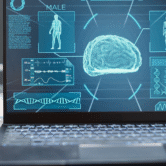How EHR Data Feeds AI Models for Better Clinical Decisions
AI is another name of intelligent system that is working to make every working arena better. By collecting and using useful information, it helps to improve the decision-making processes by providing quality data gathered on the basis of analytics.
EHR data feeds are essential to healthcare AI models because they enable them to make more intelligent and precise decisions. In essence, these artificial intelligence (AI) systems use all of the comprehensive patient data kept in electronic health records (EHRs), including past diagnoses, test results, prescriptions, and medical histories, to identify trends and insights that could be overlooked in real-time clinical settings. Clinicians may benefit from real-time, data-driven recommendations and alerts that help them identify problems early, prevent mistakes, and customize treatment strategies for each patient by feeding AI with this rich, structured data. Machine learning in EHR functions as a kind of super-powered backroom assistant, evaluating enormous volumes of data to help doctors make decisions.
How AI models use the data and provide information for better clinical decisions
AI models employ a number of crucial procedures to enhance clinical decision-making using EHR data. They do it this way:
1. Extraction and Structure of Data
EHRs contain both structured and unstructured data, like notes, lab results, prescriptions, and medical histories, which AI models first extract. This data is cleaned, arranged, and prepared for analysis by transforming it into formats that can be used.
2. Identifying Patterns
Large volumes of data are analyzed by AI algorithms to find hidden trends and patterns in patient health, including relationships between diagnosis, treatments, and symptoms.
AI can now forecast outcomes like the chance of readmission or illness progression as a result.
3. Analytical Prediction
In order to forecast future occurrences, such as the likelihood of complications, heart attacks, or chronic diseases, AI models utilize prior EHR data.
Predictive analytics AI algorithms forecast future occurrences, like the likelihood of heart attacks, chronic diseases, or consequences, using existing EHR data.
Based on a patient’s medical history and lab findings, AI may, for example, identify those who are at danger of heart failure or sepsis.
4. Support for Clinical Decisions (CDS)
Based on EHR data, AI-powered CDS systems provide real-time alerts and recommendations. Potential diagnosis, medication interactions, follow-up care reminders, or informing doctors of unusual lab results are a few examples of these recommendations.
5. Tailored Treatment Programs
AI recommends individualized treatment regimens based on the patient’s medical history, present ailments, and particular needs using patient-specific EHR data. This results in more focused, customized care and can improve patient outcomes.
6. Automated Decision Assistance
Using patient data, AI can help with routine decision-making, such as choosing the right drugs or diagnostic testing. This reduces physician burnout by giving AI some of the decision-making responsibilities.
7. Cutting Down on Human Error
By comparing patient data with extensive medical databases and spotting discrepancies or overlooked diagnoses, AI reduces diagnosis errors. Additionally, it offers prompt notifications for possible pharmaceutical mistakes, like incorrect dosage or dangerous drug combinations.
8. Better Diagnostics
AI can increase the precision and speed of diagnosis by evaluating EHR data in conjunction with lab or diagnostic imaging results.AI can spot patterns that the human eye might miss, which could help discover unusual disorders or diseases like cancer early.
9. Ongoing Education & Input
AI models keep learning and adapting as more patient data becomes accessible, thereby improving their forecasts and suggestions. This establishes a feedback loop that guarantees current care and continuously enhances clinical decision-making.
Thus, by predicting outcomes, tailoring therapy, identifying mistakes, and offering immediate, actionable insights, AI models leverage EHR data to improve clinical decisions, ultimately leading to better patient outcomes and the entire healthcare experience.
Benefits of AI in Electronic Health Records
Improved Early Detection & Predictive Analytics
Artificial intelligence (AI) systems can examine medical information to find hidden patterns, such as early disease indicators, that improve the speed and accuracy of diagnoses. For instance, trials in England showed that the “C the Signs” program increased cancer diagnosis rates from 58.7% to 66.0%.
Enhanced productivity and decreased burnout
Clinical visits are automatically recorded by AI scribes and helpers, relieving physicians of paperwork so they can concentrate on their patients. Documentation time was significantly reduced in one clinic.
Clinical decision support based on data (CDS)
By identifying medication interactions, highlighting hazards, and recommending treatments, AI linked with EHRs improves CDS and helps patients make better decisions.
Challenges confronted
Data fragmentation and interoperability issues with AI using EHR data
AI finds it challenging to acquire consistent, thorough patient data since EHR systems frequently operate on antiquated, compartmentalized architecture.
Problems with data quality
If EHR entries are not properly cleaned and standardized, they may contain errors, missing values, inconsistent formats, or unstructured content, all of which compromise AI accuracy.
Fairness and bias
Unfair clinical recommendations could result from AI based on biased historical data. To address this, a variety of datasets and continuous observation are needed.
Explainability and transparency
Since many AI models operate as “black boxes,” confidence may be damaged by their opacity. Although explainable AI (XAI) techniques like SHAP and LIME are necessary, they frequently come with trade-offs.
High expenses and resource requirements
It can be difficult for smaller practices to deploy AI because it necessitates large investments in software, infrastructure, staff training, and upkeep.
Resistance to adoption among clinicians
Because they fear job displacement or workflow disruptions, healthcare personnel may oppose AI solutions if they lack user-friendly design and adequate training.
Conclusion:
When artificial intelligence (AI) leverages the rich, diverse data found in electronic health records, clinical decision-making may really advance. AI systems that have access to patient histories, test results, prescription drugs, and more can provide real-time insights, predictive alarms, efficient workflows, and truly individualized care, increasing accuracy and relieving overburdened caregivers.
There are some obstacles in the way of this better future, though. There are technical obstacles that make it difficult for AI to function consistently across various EHR platforms, such as inconsistent and fragmented data and system integration.
It is impossible to overlook the significant organizational issues of fostering clinician trust, controlling expenses, and seamlessly integrating AI into current processes.




